
by Gideon Marcus
Of horses and streams
Tom Paine is trying the most desperate of Hail Mary passes. Aviation Weekly just published a piece that the NASA administrator is pitching the idea of an international space station with at least six astronauts from a number of countries, possibly even from behind the Iron Curtain, to be launched in the Bicentennial year of 1976.
The price? Diverting Apollos 15 and 19 to the Skylab program, scheduled to start in 1972, and shifting Apollos 17 and 18 to the new space station. As a result, only two more Apollo missions would fly to the Moon.
There's some logic to this—after all, the Soviets have given up on the Moon, and we've already been twice. Moreover, the Reds are now focusing on orbital space stations (if the recent Soyuz 9 flight and the prior triple Soyuz mission are any indication). Shouldn't we change course, too?
I have to think this idea a plan to save the Space Shuttle. With Senators Proxmire and Mondale sharpening their knives to gut the space agency's budget, Paine figures that the way to keep the next-generation orbital launch vehicle in business is to give it a fixed destination. After all, once the two Apollos have been used, the only way to get astronauts to the station will be on the Space Shuttle.

A Space Shuttle Orbiter docks with the NAR Phase B Space Station using a module deployed from its payload bay and linked to the docking port atop its crew cabin. Image credit: North American Rockwell. (text by David Portree)
The timing is awfully tight, though. The Shuttle won't be done until at least 1977, which means the station will have to lie fallow for a while until the vehicle is online. That's assuming the advanced station can even be developed and deployed in six years, which seems doubtful. Skylab is just an adapted Saturn V upper stage. This proposed station would probably be something entirely new.
In any event, it seems foolish to squander Kennedy's legacy and barely scratch the surface of the Moon, scientifically speaking, when an infrastructure for further exploration is already in place. Shifting course so rapidly stinks of desperation. As Walter Matthau once said, playing a gambler in an episode of Route 66, "Scared money always loses."
Of dolphins and dreams
The realm of science isn't the only dubious one this month. Take a gander at the latest issue of Fantasy and Science Fiction to see what I mean…
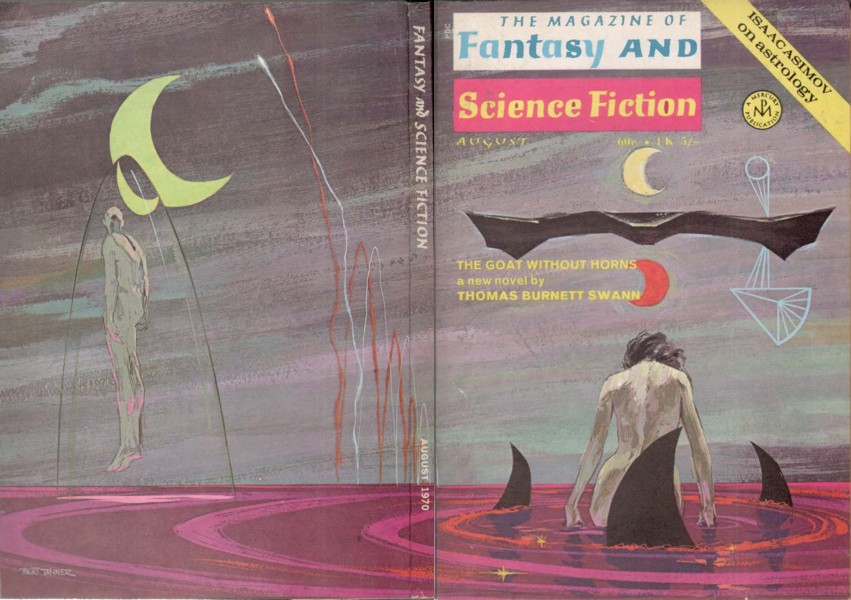
Cover by Bert Tanner
The Goat Without Horns (Part 1 of 2), by Thomas Burnett Swann
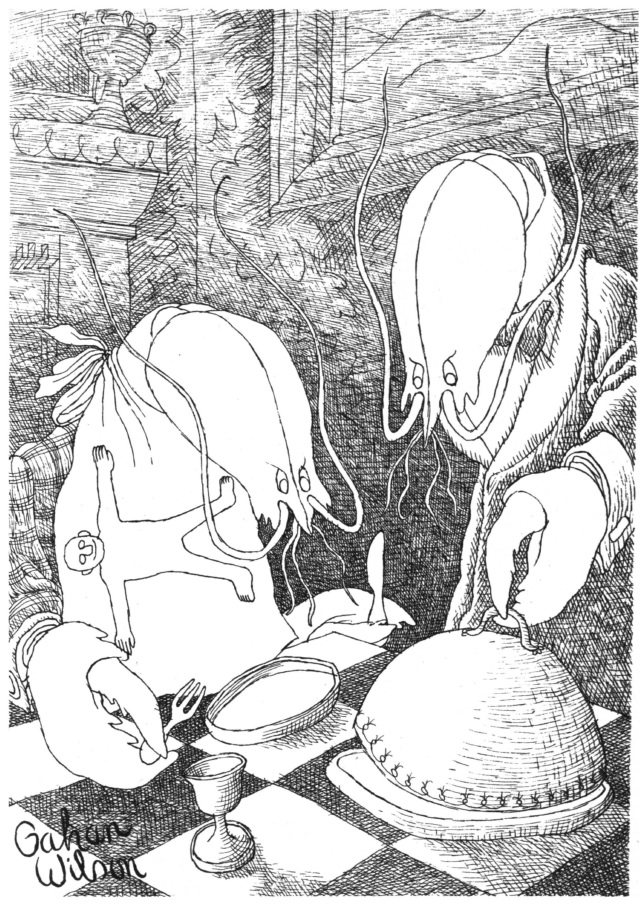
cartoon by Gahan Wilson
Charlie, a late 19th Century 19-year old college dropout from England, answers an ad for a most unusual position—tutor for a teenaged girl on a remote Caribbean island. The sensitive young man, half poet, half sports enthusiast, arrives and is immediately smitten with the girl's mother, a dissipated, self-described "fallen woman". Jill, the girl, is less keen on Charlie. She feels more kinship with Gurk, last of the Carib Kings, who rules over the degenerate island villagers with an iron fist…when he isn't cavorting with his shark friends.
But Charlie's closest companion is the dolphin, "Gloomer", who is actually the narrator. It turns out that dolphins are not only highly intelligent, but they speak our languages and have an oral tradition. "The Goat Without Horns", is, in fact, the transcription of Gloomer's tale by a "Thomas Burnett Swann" that reads (perhaps consciously) like a Gothic romance.
Gloomer and Charlie have reason to be apprehensive, for Charlie has been recruited for a sinister purpose, unrevealed until the end of this Part…
Swann is an author best known for using classic myths as fodder for fantasy and science fiction tales. I'm sure this one has a similar origin, but I confess that I don't know what it is. The piece is readable enough, but it also feels a bit like an overserious, overpadded Brigadier Ffellowes tale.
Three stars so far.
Books (F&SF, August 1970), by James Blish

John Lymington is, per James Blish, "a mainstream writer who tries to write science fiction without, apparently, ever having ready any, and without, obviously, any knowledge whatsoever of any science…and had better scuttle back to the historical novel as fast as his little legs will carry him." And that's all you need to know about Lymington's first SFnal effort, Ten Million Years to Friday.
Julius Fast's The League of Grey-eyed Women, conversely, is "a fairly far-out story of lycanthropy and telepathy, very well constructed both in plot and in pacing," but in the outmoded style of "the woman's-magazine novel".
Blish much enjoyed D. G. Compton's The Steel Crocodile, as did Brian when he reviewed it, and he hails as a tour de force Davidson's The Phoenix and the Mirror, which takes place in "the Roman Empire of the first century B.C., as viewed through the eyes of people living about the 9th century A.D.–who knew almost nothing about Vergilian Rome and thus transformed it into an analogue of the Holy Roman Empire…told in the language of 14th century Arthurian romance, as handled by a 20th century man who has absorbed every trick of the narrator's trade which has been developed since."
The Self-Priming, Solid-State Electronic Chicken, by Jon Lucas
Analog-style tale with a twist at the end: a phony manufacturing firm hooks a mark who offers up an artificial egg making machine. But after the inventor is in for thousands of bucks, the firm realizes they have the real deal and become genuine partners. Only to find that…
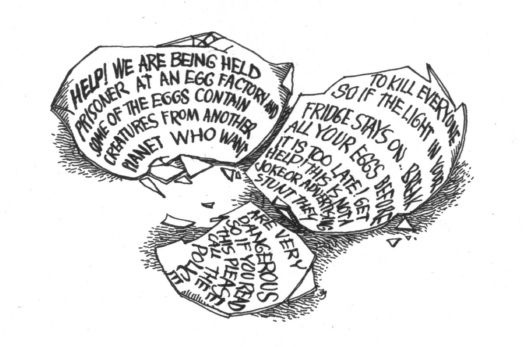
Honestly, this story could have been reduced to the illustration alone and not suffered for it.
Two stars.
The Good-bye Birthday, by Maureen Bryan Exter
Nola is about to turn 16, and in the overcrowded world of Earth in the 21st Century, that means she's going to be packed into a starship, never to see home again. David, her slightly younger boyfriend, is determined to ensure that doesn't happen. But their daring escape is thwarted when Nola decides that maybe leaving the planet won't be so bad.
There's not much story here—mostly just color about living on an overpacked Earth, and the desperate measures that are taken to keep the planet inhabitable. I think Exter, a new writer, has potential, but this tale is not particularly interesting.
Two stars.
Confessions, by Ron Goulart
Ron Goulart likes to write characters with serial adventures. First (for me, anyway), there was Max Kearny, the occult detective. Along with his wife, they solved crimes. These stories were just the right combination of affectionate, whimsical, and serious.
Then came Ben Jolson, a shape-changing secret agent. His stories were more whimsical and less compelling.
Now we've got Jose Silvera, a ghost writer with a secret agent's skills, which he has honed to collect from skinflint publishers. "I either collect my money or I don't. Most often, I do." In this particular instance, Silvera is on the planet Murdstone trying to retrieve $2000 from McLew Scribbley of the BlackHawk Group. The problem is, BlackHawk Manor is a mobile domicile, and thus hard to pin down.
However, a recent spate of murders has stricken Murdstone, and all of them took place in the vicinity of wherever the moving home happened to be. This gets the law on Silvera's side, so that both can pursue a mutual happy ending.
I'm sure Goulart enjoys writing a character who is a cross between Charteris' "The Saint" and, well, himself, but I find the results more tedious than funny.
Two stars.
Pebble in Time, by Avram Davidson and Cynthia Goldstone
This vignette tells the tale of how San Francisco became the Mormon capital after an unlikely incident involving Brigham Young, time travel, and a misadventure near The Great Salt Lake.
My fellow traveler, Kris, recently quit reviewing Orbit, complaining that its contents have all become a certain kind of over-literate, over-affected faffery, and this story is perfectly emblematic of that style. I'm sure people love it, but it's getting on my nerves.
Two stars.
The Stars in Their Courses, by Isaac Asimov

The Good Doctor presents the history of astrology from its ancient conception to the dawn of science, recognizing it for what it was—a genuine attempt to interpret the heavens in an orderly fashion. I assume he's going to take down the fraud it has become in the next installment.
Four stars.
Out of Control, by Raylyn Moore
A middle-manager suffers a nervous breakdown and turns to creative writing. Assiduous effort, and the aid of a bottle of Listerine, facilitate the creation of a fantasy universe of his own creation, including the voluptuous lady, Lorelei. But characters with no independent existence pall in comparison with the real world, as he eventually finds out.
I enjoyed the story well enough until the let-down ending, which I imagine was supposed to be funny, but which hit me wrong.
Two stars.
Fading gleam
F&SF had been pretty good the last several months, but this issue is just kind of limp. In fact, save for the Asimov article, it's eminently skippable. I suppose if Mssrs. Mondale and Proxmire really want to cut something, they could start with the summer issues of Ferman's mag…
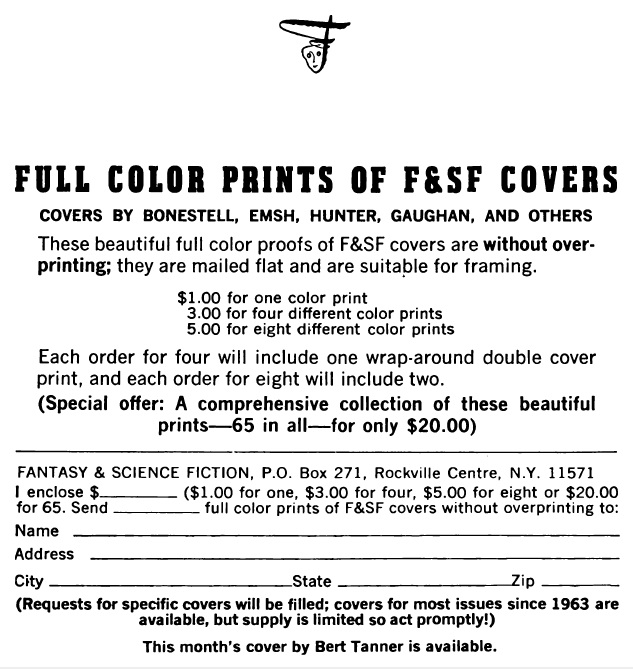
[New to the Journey? Read this for a brief introduction!]

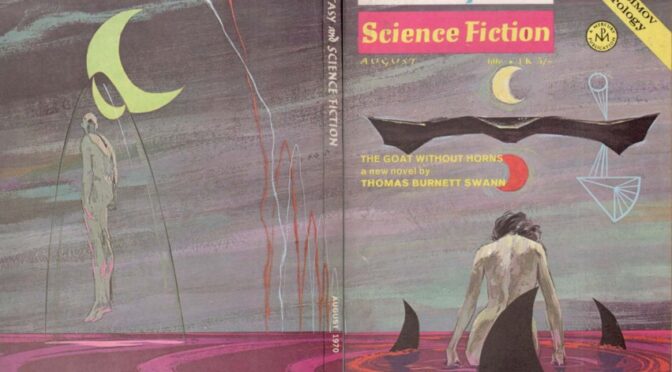


I haven't read much Swann, but what I have, I've enjoyed. This new novel, though, is moving much too slowly. An "overserious, overpadded Brigadier Ffellowes tale" hits the nail right on the head. There's room for a lot to happen in the next installment, but we could have gotten there a lot faster.
"Electronic Chicken" (which could easily have been the name of a band a year or two ago) was also overpadded. Even trimmed down, it wouldn't have been worth the effort.
A more experienced writer might have been able to turn "The Good-bye Birthday" into a decent story. Even then it would have been a forgettable three. There's something there about growing up, the loss of innocence, that sort of thing.
Goulart's Jose Silvera stories just don't work. I wonder who stiffed Ron this time.
"Pebble in Time" is another one that's too long. I also can't see San Francisco becoming the Mormon capital. The Gold Rush would have kicked off soon after they would have arrived there, and Frisco was simply too important to moving all that gold. Not to mention the fact that the whole area was firmly under the control of the U.S. Army after the Bear Flag Revolt broke Alta California away from Mexico.
Dr. A's article had nothing new for me, though he told it relatively well. It's the next part that will make or break this short series.
I don't think the ending of "Out of Control" was meant to be humorous. It's more of a darkly ironic, Twilight Zone sort of thing, like Burgess Meredith breaking his glasses. I don't know if that really helps, but it might get it to three stars.